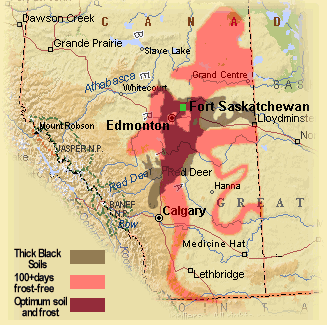What’s Northern Vigor?

Take two cuttings from a single potato plant in a lab. Plant one cutting as far north as possible, in Alaska or central Alberta. Plant the other in California. When the plants are grown, harvest the tubers and plant them as seed in the same field in Idaho. Genetically they are identical. The only difference is that one seed was grown in the north, the other in the south. But the seed potatoes which came from the north, will yield nearly 30 per cent more. That’s “Northern Vigor.”
Why do genetically similar plants vary in production, based on the latitude in which their predecessors were cultured? This unusual phenomenon is called “northern vigor” and scientists believe that the long summer days in the far north produce potatoes with more robust sugars and enzymes, and more productive power. While the growing day in June for seed potatoes grown in the Northern U.S. may end at 9 p.m., potato plants in Central Alberta are in full daylight for at least another hour, and even at midnight the sun glows faintly in the North.
Norbest Farms is in a unique growing area for potatoes.
The map above shows a red shaded area. That’s the area of Alberta which averages at least 100 frost-free days each year. There’s another dark shaded area on the map. That shows the region of “Thick Black Soil” in Alberta. Fort Saskatchewan (marked in green) is at the northern end of this area of rich soil. Go much further north and both the soil and climate make it difficult to grow potatoes.
Why buy your seed from a producer so far North?
You get the maximum benefit of Northern Vigor, caused by the long summer days in Central Alberta. While the growing season is long enough to grow potatoes, it’s bitterly cold during the winter. With temperatures dropping to -40° on some winter nights, it’s too cold up here for man or microbe. Well, the people survive, but microbes haven’t discovered down parkas yet. Combine these two factors of Northern Vigor with advanced seed potato production and handling facilities and you have some of the finest seed potatoes grown in the world.
Norbest Farms grows seed potatoes in the rich soil of the North Saskatchewan River Valley located in Northern Alberta, Canada. The Visser family has farmed and has grown potatoes since the 1950s. Norbest Farms is currently run by Gord Visser, the third generation of this family-owned potato enterprise.
Norbest Farms is located in an agricultural area that is ideally suited for growing potatoes. The area’s sandy loam soil, combined with our ability to irrigate our potato crop with water from the nearby North Saskatchewan River, enables us to produce fantastic seed potato crops.
Production
Norbest’s production standards reflect its unique climate “Northern Vigor”, its location, and the latest technology and research in growing potatoes. Irrigation and blight control are two critical factors in successful seed potato production.

Irrigation– While Northern Alberta gets enough rainfall in many seasons for a good potato crop, rainfall is not predictable. Norbest Farms uses irrigation to ensure consistent seed potato size and quality. Irrigation is also used at harvest time to mellow the soil. This reduces clumps during harvest and makes it easier to handle the potatoes with less bruising.
Blight Control– Northern Alberta is currently free of late potato blight, and because the region is used primarily for production of seed potatoes, it is well isolated from major production areas further south where blight can be a problem. Blight-free seed potatoes are essential for efficient and profitable potato production and reduce input costs for fungicide and other control measures.
Storage and Handling
The main storage and handling area of Norbest Farms is designed to handle high volumes of potatoes efficiently and cleanly. A long loading area (behind the four doors at the front) can load up two tandem trailer units at a time, in insulated, heated comfort. Four 260-by-72-foot storage bins (one each in line with the four doors) hold 44,000 bags of potatoes each in a climate-controlled environment.
We don’t rush potatoes through here. The loading area is large so that everything can be handled indoors. A huge indoor pre-grading bin holds two semi-trailer loads so we can get our trucks moving again quickly during harvest, but we can take our time getting potatoes into the bins.

